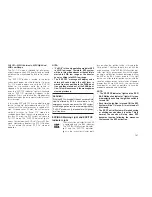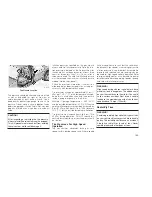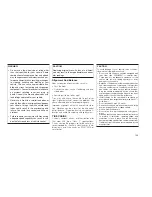
CAUTION!
Do not load your vehicle any heavier than the
GVWR or the maximum front and rear GAWR. If
you do, parts on your vehicle can break, or it can
change the way your vehicle handles. This could
cause you to lose control. Also, overloading can
shorten the life of your vehicle.
TRAILER TOWING
In this section, you will find safety tips and infor-
mation on limits to the type of towing you can
reasonably do with your vehicle. Before towing a
trailer, carefully review this information to tow your
load as efficiently and safely as possible.
To maintain warranty coverage, follow the require-
ments and recommendations in this manual con-
cerning vehicles used for trailer towing.
Common Towing Definitions
The following trailer towing related definitions will
assist you in understanding the following informa-
tion:
Gross Vehicle Weight Rating (GVWR)
The Gross Vehicle Weight Rating (GVWR) is the
total allowable weight of your vehicle. This in-
cludes driver, passengers, cargo, and tongue
weight. The total load must be limited so that you
do not exceed the GVWR.
Gross Trailer Weight (GTW)
The Gross Trailer Weight (GTW) is the weight of
the trailer plus the weight of all cargo, consum-
ables, and equipment (permanent or temporary)
loaded in or on the trailer in its
"
loaded and ready
for operation
"
condition. The recommended way
to measure GTW is to put your fully loaded trailer
on a vehicle scale. The entire weight of the trailer
must be supported by the scale.
WARNING!
If the Gross Trailer Weight (GTW) is 3,500 lbs (1
587 kg) or more, it is mandatory to use a
weight-distributing hitch to ensure stable han-
dling of your vehicle. If you use a standard
weight- carrying hitch, you could lose control of
your vehicle and cause an accident.
Gross Combination Weight Rating (GCWR)
The Gross Combination Weight Rating (GCWR) is
the total permissible weight of your vehicle and
trailer when weighed in combination. (Note that
GCWR ratings include a 150 lbs (68 kg) allowance
for the presence of a driver).
Gross Axle Weight Rating (GAWR)
The Gross Axle Weight Rating (GAWR) is the
maximum capacity of the front and rear axles.
Distribute the load over the front and rear axles
evenly. Make sure that you do not exceed either
front or rear GAWR.
WARNING!
It is important that you do not exceed the maxi-
mum front or rear GAWR. A dangerous driving
condition can result if either rating is exceeded.
You could lose control of the vehicle and have an
accident.
Tongue Weight (TW)
Tongue weight (TW) is the downward force ex-
erted on the hitch ball by the trailer. In most cases,
it should not be less than 10% or more than 15%
of the trailer load. You must consider this as part of
the load on your vehicle.
Frontal Area
Frontal area is the maximum height and maximum
width of the front of a trailer.
Trailer Sway Control — Electronic
Refer to “TSC (Trailer Sway Control)” under “Elec-
tronic Brake Control System” in this section for
information on this system.
155
Summary of Contents for Cherokee 2009
Page 1: ......
Page 2: ......
Page 3: ......
Page 5: ...2...
Page 9: ...6...
Page 11: ...8...
Page 15: ......
Page 45: ...42...
Page 50: ...Rear Window Defroster If Equipped 89 ROOF LUGGAGE RACK IF EQUIPPED 90 47...
Page 51: ......
Page 63: ...60...
Page 64: ...61...
Page 65: ...62...
Page 97: ...INSTRUMENT CLUSTER 94...
Page 106: ...Compass Variance Map 103...
Page 111: ...Compass Variance Map 108...
Page 116: ......
Page 120: ...117...
Page 123: ...Control Setting Suggestions for Various Weather Conditions 120...
Page 147: ......
Page 159: ......
Page 162: ......
Page 175: ...172...
Page 179: ......
Page 210: ...9 IF YOU NEED CONSUMER ASSISTANCE IF YOU NEED ASSISTANCE 208 207...
Page 212: ...209...
Page 213: ...210...
Page 214: ...10 INDEX 211...
















































